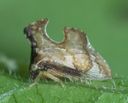Entylia
Entylia
Classification
- Phylum: Arthropoda
- Subphylum: Hexapoda
- Class: Insecta
- Order: Hemiptera
- Suborder: Auchenorrhyncha
- Infraorder: Cicadomorpha
- Superfamily: Membracoidea
- Family: Membracidae
- Subfamily: Smiliinae
- Tribe: Polyglyptini
- Genus: Entylia
Pronunciation
How to pronounce Entylia: /ɛnˈtɪliə/
These audio files are automatically generated. While they are not always 100% accurate, they are a good starting point.
Images






Summary
Entylia carinata, or the keeled treehopper, is a small, brown sap-feeding insect endemic to the Americas renowned for its unique saddle-shaped keels and symbiotic relationships with ants that tend to them and their nymphs.
Physical Characteristics
Keeled treehoppers are small and brown with unique saddle-shaped keels. They exhibit sexual dimorphism: females typically measure 1/4 of an inch (6.35 mm) with pronounced keels, while males are smaller with less noticeable keels.
Identification Tips
Look for the distinct saddle-shaped keels on the back of these insects. Males may sometimes be misidentified due to their appearance.
Habitat
Keeled treehoppers are commonly found on various plants, especially in the family Asteraceae. They prefer habitats with susceptible plant growth during the spring.
Distribution
These insects are distributed across Canada, the eastern United States, Mexico, Central America, and South America.
Diet
Keeled treehoppers feed on plant sap extracted from various plants, primarily those in the Asteraceae family.
Life Cycle
As adults, they overwinter in leaf litter and debris, emerging in March. They implant their eggs on aster leaves, where the eggs cause the leaf to fold over, providing protection for the nymphs once hatched.
Reproduction
Females lay eggs on host plants, preferably during spring when the plants exhibit vulnerable growth and soft tissues.
Ecosystem Role
Keeled treehoppers play a role in their ecosystem by participating in ant-tending mutualism, with ants protecting them and feeding on their honeydew.
Economic Impact
Not considered significant plant pests; they do not transmit plant diseases.
Evolution
The genus Entylia is likely to be monotypic, with an association that could lead to the synonymization with Publilia.
Misconceptions
Males may be misidentified due to their appearance, often appearing significantly different from females.
Tags
- Insect
- Hemiptera
- Treehopper
- Entylia carinata
- Symbiosis
- Asteraceae